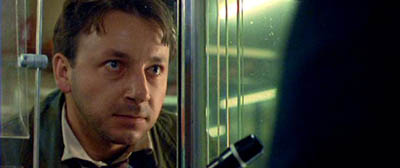
BETTER LUCK TOMORROW
I had a string of bad luck last month. Problems would slam me out of nowhere and last time, that problem was actually a car. I made a left turn one afternoon and then bam, I found myself confounded in my first vehicular accident. My driving this lagging, sputtering, and soon-to-die-on-me journal seems so minor now. I wish I had seen “White” a month ago. It’s a movie about luck, you see. It would have given me a new perspective and perhaps, a bit of chuckle as well.
“White,” mid-stuck in Kieslowski’s “Three Colors” trilogy, trails a Polish hairdresser named Karol ( Zbigniew Zamachowski). The camera initially shoots the down-on-luck man at a low angle; his legs apprehensively walk to court. He finds out Dominique (Julie Delpy), his gorgeous French wife, seeks a divorce; she contends the marriage is not consummated. Karol is devastated, but his cruel misfortune does not end there. The ATM confiscates his credit card; his bank account is frozen. To get sleep, the foreigner sneaks inside his now ex-wife’s salon. The next day, Dominique, without an ounce of pity, kicks him out and calls the police. With his passport lost and his money out of reach, Karol is stuck in the limbo of Paris. His last resort: beg for change in the subway… by playing his papered-covered pocket comb like it’s a harmonica.
Honestly, I get anxious when I see a movie by Kieslowski, partly because the Polish auteur might be my favorite filmmaker of all time. The greatest thing about his movies is not really about watching them, but rather reflecting back on them. His works are ripe for film analysis. As with most movies, I went into this one cold, but I knew Kieslowski’s mastery in incorporating themes and symbolism. I knew I had to be alert for the movie-journey is full of clues and details. Not surprisingly, the color white is a recurring sight: the bright lights, the snow, Karol’s head statue, and the wedding dress. Hmm… what could they all symbolize?
I later find that the overall theme of the movie is equality. Ahhh, I thought that makes sense. Kieslowski seems to be putting the story elements and its characters in a weighing scale and playing with their balance. The yin-yang portrayal of Karol and Dominique itself is fascinating. Marriage is supposed to be of equal partnership, but when one person dominates the other, the relationship is grotesque and askew. The director illuminates this imbalance by putting Dominique above Karol literally and figuratively. She’s on top during sex; he can’t get it up. She’s up on the balcony; he’s down in the subway. She’s beautiful. He’s a hairdresser, a servant to beauty. She’s French, born with a snotty whiff of arrogance. And he’s a down-to-earth Polish.
The other form of equality represented here is luck, symbolized by Karol’s flipping coin. Interestingly, Kieslowski does not depend too much on plot to maneuver the story. He doesn’t jerk his characters around by extremely (un)lucky circumstances. The characters drive most of the action; they’re not helpless to the whim of fate. It makes the protagonist more compelling, as he works his butt off to recover from misfortune. I think the lesson is here that we create our chance. The lucky ones aren’t the born privileged. The lucky ones are the resilient; their lives are not boring and constant, but rather akin to an exciting up-and-down roller coaster ride.
Grade: A
 |
CAST Zbigniew Zamachowski, Julie Delpy, Jerzy Stuhr, and Janusz Gajos Screenplay by Krzysztof Piesiewicz Krzysztof Kieślowski Directed by Krzysztof Kieślowski Rated R for some sexuality and language |